 We are now in the northern part of this long skinny
We are now in the northern part of this long skinny country, though we won’t make it all the way to the Peruvian border. San Pedro de Atacama has been our base for digging into what makes this region tick. The geography here is truly staggering. Think of Nevada with its deserts, Utah with its eroded landscapes, the snow covered peaks higher than any of the high Sierra, and Colorado fourteeners in one long, long stretch sweeping north-south by 12 degrees of latitude. There are something like 6 “cities” along this skinny strip of land that is as long as the distance from San Diego to Seattle. This is a vast region of barely inhabited expanses. Gas stations are at least a half a tank apart and a tank of gas for our little car costs us $80 US!
country, though we won’t make it all the way to the Peruvian border. San Pedro de Atacama has been our base for digging into what makes this region tick. The geography here is truly staggering. Think of Nevada with its deserts, Utah with its eroded landscapes, the snow covered peaks higher than any of the high Sierra, and Colorado fourteeners in one long, long stretch sweeping north-south by 12 degrees of latitude. There are something like 6 “cities” along this skinny strip of land that is as long as the distance from San Diego to Seattle. This is a vast region of barely inhabited expanses. Gas stations are at least a half a tank apart and a tank of gas for our little car costs us $80 US!
 San Pedro de Atacama is a little dusty adobe town filled
San Pedro de Atacama is a little dusty adobe town filled with world travelers who are mostly in their 20’s. The village looks like Taos, New Mexico about 30 years ago, with the addition of many, many tour agencies and over-priced simple restaurants and the touts who go with them. Almost all tourists who arrive here come by bus either from a regional airport about 2 hours away or from Santiago, a 24 hour bus ride. The tour operators then take these tourists on half-day to full-day tours of the many unusual sights offered in this driest place on Earth. We used our little car to visit salty lakes where flamingos nest, iridescent volcanic lakes at 14,000 ft elevation nestled below
with world travelers who are mostly in their 20’s. The village looks like Taos, New Mexico about 30 years ago, with the addition of many, many tour agencies and over-priced simple restaurants and the touts who go with them. Almost all tourists who arrive here come by bus either from a regional airport about 2 hours away or from Santiago, a 24 hour bus ride. The tour operators then take these tourists on half-day to full-day tours of the many unusual sights offered in this driest place on Earth. We used our little car to visit salty lakes where flamingos nest, iridescent volcanic lakes at 14,000 ft elevation nestled below 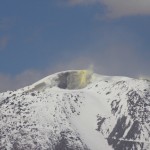 16,000 ft peaks, ruins of cultures long past, and geyser fields
16,000 ft peaks, ruins of cultures long past, and geyser fields bubbling and squirting their hot water and steam into the frigid winds at 15,000 ft. The only tour we took was because a crazy French amateur astronomer has set up 10 telescopes out in the desert and gives tours of the universe in Spanish, French and English. The dry and high night sky here provides truly wonderful views with the jewel-like Southern Cross gleaming in a pristine Milky Way.
bubbling and squirting their hot water and steam into the frigid winds at 15,000 ft. The only tour we took was because a crazy French amateur astronomer has set up 10 telescopes out in the desert and gives tours of the universe in Spanish, French and English. The dry and high night sky here provides truly wonderful views with the jewel-like Southern Cross gleaming in a pristine Milky Way.
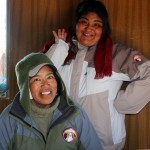 What we have been experiencing is here termed
What we have been experiencing is here termed 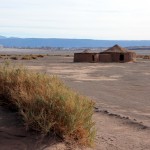 “Eco-Etno Turismo”. The federal agency, CONAF, Chile’s forestry department, is charged with environmental protection. It teams up with local indigenous peoples, organized by villages, to develop ways for tourists to experience both nature and culture, past and present, while controlled and guided by local people. At each location we were greeted by a local person, often looking quite Peruvian or Bolivian, in contrast with the European faces to which we have become so accustomed. After paying the normal $2 – $5 entrance fee, our visits were carefully circumscribed by paths and lines of stones, etc.. The effect is that the thousands of tourists’ feet that visit these sites leave no trace on most of the visual landscape. The sand dune on the other side of the line of rocks is sculpted only by the incessant winds.
“Eco-Etno Turismo”. The federal agency, CONAF, Chile’s forestry department, is charged with environmental protection. It teams up with local indigenous peoples, organized by villages, to develop ways for tourists to experience both nature and culture, past and present, while controlled and guided by local people. At each location we were greeted by a local person, often looking quite Peruvian or Bolivian, in contrast with the European faces to which we have become so accustomed. After paying the normal $2 – $5 entrance fee, our visits were carefully circumscribed by paths and lines of stones, etc.. The effect is that the thousands of tourists’ feet that visit these sites leave no trace on most of the visual landscape. The sand dune on the other side of the line of rocks is sculpted only by the incessant winds.
Our style of tourism isn’t really for the faint-of-heart, at least if yesterday was any example. One of the things to do here is to visit the Tatio Geysers, the highest geyser field in the world. Everyone (but us) signs up for the $20 US tour which departs at 4 am and returns to San Pedro de Atacama at noon. The geysers are 115 km north of town and getting there at dawn is the tour goal to see the steam and geysers in the cold and often windless morning calm. Our plan was different. Why not leave much later and see the geysers without the tour groups and then continue on to the ‘nearby’ city, Calama? So we took
any example. One of the things to do here is to visit the Tatio Geysers, the highest geyser field in the world. Everyone (but us) signs up for the $20 US tour which departs at 4 am and returns to San Pedro de Atacama at noon. The geysers are 115 km north of town and getting there at dawn is the tour goal to see the steam and geysers in the cold and often windless morning calm. Our plan was different. Why not leave much later and see the geysers without the tour groups and then continue on to the ‘nearby’ city, Calama? So we took  another walk through the terrific cultural history museum in San Pedro de Atacama, made another trip to the bank for money (same result as the past 3 days, the bank has no money), and then we began to drive north on the jeep roads toward the geysers. After an hour or so we had a choice. Our map showed two routes forward. We chose the left one – why not? This road
another walk through the terrific cultural history museum in San Pedro de Atacama, made another trip to the bank for money (same result as the past 3 days, the bank has no money), and then we began to drive north on the jeep roads toward the geysers. After an hour or so we had a choice. Our map showed two routes forward. We chose the left one – why not? This road 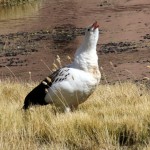 wiggled in narrow canyons and switch-backed up over hills and eventually we came to a fertile valley with geese, ducks and some llamas – and – a big, brown expanse of water to be forded. It seemed like a good time for lunch, so we sat in the car and watched the animals and ate our cheese, bread and apples and waited. After a while a large truck came and approached the ford from the other side. After a brief pause, the truck
wiggled in narrow canyons and switch-backed up over hills and eventually we came to a fertile valley with geese, ducks and some llamas – and – a big, brown expanse of water to be forded. It seemed like a good time for lunch, so we sat in the car and watched the animals and ate our cheese, bread and apples and waited. After a while a large truck came and approached the ford from the other side. After a brief pause, the truck  buried its nose, wheels (and more) and plowed through. Hmm…. This did not look like what we should do with our little 4-wheel-drive Suzuki. So, we turned around, went back down for an hour and then took the correct fork at the junction. This road wound higher and higher and higher and the little car persevered even though it really wanted more air to breathe, as did both of us. About 4
buried its nose, wheels (and more) and plowed through. Hmm…. This did not look like what we should do with our little 4-wheel-drive Suzuki. So, we turned around, went back down for an hour and then took the correct fork at the junction. This road wound higher and higher and higher and the little car persevered even though it really wanted more air to breathe, as did both of us. About 4 pm we finally reached the geyser field, met the local indigenous guides, paid the fees, and had the place to ourselves. Now it was 5 pm as we started on toward Calama. We have learned that sunset occurs at 6 pm here and it gets very dark very quickly after that. That hour
pm we finally reached the geyser field, met the local indigenous guides, paid the fees, and had the place to ourselves. Now it was 5 pm as we started on toward Calama. We have learned that sunset occurs at 6 pm here and it gets very dark very quickly after that. That hour 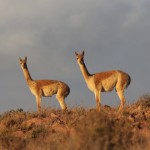 before sunset is a photographer’s delight. So we drove toward the setting sun, stopping to observe and sometimes photograph the changing colors and contrasts. We also stopped because with the sun was often in our eyes, and many times we could barely see the jeep road as the car crawled uphill toward the sun. This presaged a slow passage on slow roads. Soon it was dark, and we still had many kilometers to drive on vestigial, potholed and wash-boarded roads.
before sunset is a photographer’s delight. So we drove toward the setting sun, stopping to observe and sometimes photograph the changing colors and contrasts. We also stopped because with the sun was often in our eyes, and many times we could barely see the jeep road as the car crawled uphill toward the sun. This presaged a slow passage on slow roads. Soon it was dark, and we still had many kilometers to drive on vestigial, potholed and wash-boarded roads.
By the time we reached Calama we were glad that we had not had any calamities. We were exhausted and we still had to figure out where to stay for the night and where to get some dinner. Val dropped Leslie in front of one of the hotels recommended in our “Lonely Planet” travel guide and tried to go around the block with the car as the street was very busy and there was no parking available. After a snarl of traffic and one-way streets, Val eventually returned to find Leslie snarling on the sidewalk, saying that we were certainly not going to stay in THAT hotel! She had met someone who, in our experience, was an unusual person in Chile – a very rude and unfriendly receptionist. After a bit more struggling, we managed to find another hotel and dinner. This unpleasant evening in an unpleasant city made us realize just how fortunate we have been with all of our positive encounters with the people of Chile.
 The Museo Gustave Le Paige in San Pedro de Atacama is a
The Museo Gustave Le Paige in San Pedro de Atacama is a wonderful place to try to get your mind to span the immense space and time of this place. The arid desert seems so inhospitable that one wonders whether anything could live here, yet the salty lakes abound with flamingos, and when a bit of grass appears on a steep hillside, often a group of vicuñas grazes. People have lived here for a long, long time. The museum shows archaeological findings from successions of peoples. Some of the earliest were agriculturalists who farmed along stream beds that are now quite dry. But climates do change. Many artifacts here come from the circular adobe structures in the nearby site,
wonderful place to try to get your mind to span the immense space and time of this place. The arid desert seems so inhospitable that one wonders whether anything could live here, yet the salty lakes abound with flamingos, and when a bit of grass appears on a steep hillside, often a group of vicuñas grazes. People have lived here for a long, long time. The museum shows archaeological findings from successions of peoples. Some of the earliest were agriculturalists who farmed along stream beds that are now quite dry. But climates do change. Many artifacts here come from the circular adobe structures in the nearby site,  Aldea de Tulor, which was inhabited for 1000 years. Evidence of shells from the coast to the west and pottery designs from the high Andes suggests that long distance trade routes through the Atacama existed for more than a thousand years. From the variety of pipes and snuff tablets displayed,
Aldea de Tulor, which was inhabited for 1000 years. Evidence of shells from the coast to the west and pottery designs from the high Andes suggests that long distance trade routes through the Atacama existed for more than a thousand years. From the variety of pipes and snuff tablets displayed,  it seemed that hallucinogens may have helped people live in this challenging place! There also is evidence that as early as 800ce craftspeople in the Atacama were specializing in metal work which was mostly copper, but there was also silver and gold. While forms and designs changed, the underlying skills of finding ore and smelting and forging were conserved. Various mountain conquerers came and traditions
it seemed that hallucinogens may have helped people live in this challenging place! There also is evidence that as early as 800ce craftspeople in the Atacama were specializing in metal work which was mostly copper, but there was also silver and gold. While forms and designs changed, the underlying skills of finding ore and smelting and forging were conserved. Various mountain conquerers came and traditions  evolved, culminating in the Inca expansion which incorporated the Atacama in the late 1400s. Throughout these waves of change, local skills and organization were incorporated into conquerors’ world views.
evolved, culminating in the Inca expansion which incorporated the Atacama in the late 1400s. Throughout these waves of change, local skills and organization were incorporated into conquerors’ world views.
Things really changed in the early 1500’s when the Spanish conquistadors arrived, which was just 70 years after the Inca had established their control. The Spanish were not interested in incorporating anything local. They 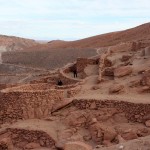 wanted riches and here it meant mostly copper and much later, nitrates. The Spanish were ruthless in asserting their control. We visited a mountain bastion, Pukará de Quitor, that had been built in the 12th century by one group defending against attacks by others. Two hundred years later, the conquistador, Pedro de Valdivia, here vanquished all these indigenous peoples, beheading hundreds. This set in motion a succession of exploitations that continues to this day.
wanted riches and here it meant mostly copper and much later, nitrates. The Spanish were ruthless in asserting their control. We visited a mountain bastion, Pukará de Quitor, that had been built in the 12th century by one group defending against attacks by others. Two hundred years later, the conquistador, Pedro de Valdivia, here vanquished all these indigenous peoples, beheading hundreds. This set in motion a succession of exploitations that continues to this day.
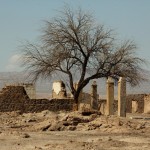 We saw evidence of mining time and again as we drove the long and desolate roads of northern Chile. Nitrate appears here in complex deposits unequaled in the world. Geologists still fight over the origin of these deposits. Indigenous peoples seem to have used these nitrates in their gardens. Europeans extracted it for centuries to power wars and provide fertilizer. Whole adobe cities are now slowly being reabsorbed into the desert as nitrate mining stopped after the invention of chemical equivalents during World War I. The mining scars will last forever.
We saw evidence of mining time and again as we drove the long and desolate roads of northern Chile. Nitrate appears here in complex deposits unequaled in the world. Geologists still fight over the origin of these deposits. Indigenous peoples seem to have used these nitrates in their gardens. Europeans extracted it for centuries to power wars and provide fertilizer. Whole adobe cities are now slowly being reabsorbed into the desert as nitrate mining stopped after the invention of chemical equivalents during World War I. The mining scars will last forever.
Copper has been mined here for thousands of years and is currently very  big business and provides Chile’s primary export commodity. Chileans with whom we have spoken credit their fairly advanced and stable economy to the high price of
big business and provides Chile’s primary export commodity. Chileans with whom we have spoken credit their fairly advanced and stable economy to the high price of  copper on the world market driven by the electrification of China. The trucks used to carry ore from the mines to trains are of a size that is hard to imagine. The tires alone are at least 2 or 3 meters in diameter. And it doesn’t stop with copper. Chile, in these high valleys, has evaporating salt lakes where much of the world’s supply of accessible lithium lies ready to be shoveled up and turned into batteries for our electronic toys and the electric cars soon to come in quantity.
copper on the world market driven by the electrification of China. The trucks used to carry ore from the mines to trains are of a size that is hard to imagine. The tires alone are at least 2 or 3 meters in diameter. And it doesn’t stop with copper. Chile, in these high valleys, has evaporating salt lakes where much of the world’s supply of accessible lithium lies ready to be shoveled up and turned into batteries for our electronic toys and the electric cars soon to come in quantity.
Realizing that we have barely scraped the surface of this intriguing place, we are turning our little car southward and our attention toward our last couple of weeks in Chile. One big question remains: Will we be able to sell the car?
[shashin type=”album” id=”36″ size=”small” crop=”n” columns=”max” caption=”y” order=”date” position=”center”]


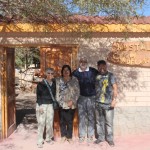
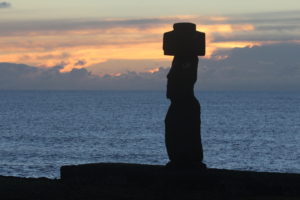
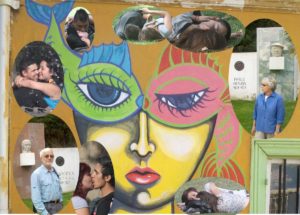
Stormy
20 May 2012Wow you guys really have been adventuring. I’m glad there was no dust storm or wind like you encountered farther south. (And the mental image of Leslie snarling on the sidewalk made me laugh out loud!)
Eric
22 May 2012what an adventure you had in Norte Grande! It takes special people to pull it off like the two of you did. As always your photos are spectacular. Many aspects of your story and photos remind me of Peru. Did you take the marvelous photo of mountains and water that comes up not in the Norte Grande blog itself, but in the main page. I wish I could see it blown up a bit larger.
ric bradley
28 May 2012Dear Leslie and Val,
Terrific blogs, beautiful photographs, fascinating narratives. Thanks so much for taking us with you on so many wonderful excursions!
Love,
Dorry and Ric